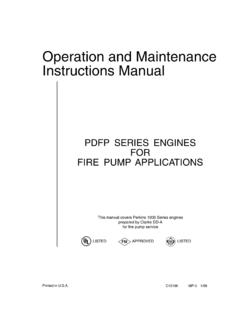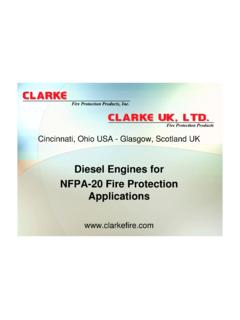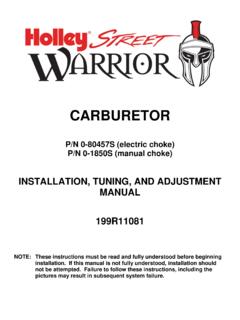Transcription of Operation and Maintenance Instructions Manual
1 Operation and MaintenanceInstructions ManualDDFP SERIES ENGINESFORFIRE PUMP APPLICATIONSThis Manual covers Detroit Diesel enginesmodified by Clarke DD-Afor fire pump servicePrinted in 7/96C13194 FMABBREVIATIONSACA lternating CurrentAECA utomatic Engine ControllerAPIA merican Petroleum InstituteCCWC ounter-clockwise engine rotating (front view)CDD-AClarke Detroit Diesel-AllisonCWClockwise engine rotation (front view)DCDirect CurrentDDCD etroit Diesel CorporationDDFPD etroit Diesel Engines approved for Fire Pump Serviceas certified by FM/UL/ULC for Clarke Detroit Diesel-AllisonFMFactory Mutual ResearchGMGeneral Motors CorporationIDIdentificationIPInstrument PanelI-53In-Line Cylinder arrangement 53 Series DDC EngineI-71In-Line Cylinder arrangement 71 Series DDC EngineNANaturally AspiratedNCNormally ClosedNONormally OpenNFPAN ational Fire Protection AssociationP/NPart NumberPSIP ounds Per Square InchPTOP ower Take OffRPMR evelutions Per MinuteSAES ociety of Automotive EngineersS/NSerial NumberTTurbochargedTATurbocharged and AftercooledULUnderwriters Laboratories Laboratories of CanadaV-92 Vee cylinder arrangement 92 Series
2 DDC enginesV-71 Vee cylinder arrangement 71 Series DDC enginesLISTEDAPPROVEDLISTEDFMTABLE OF CONTENTSSUBJECTPA G Inside Front CoverDESCRIPTION Section 1 Principles of Operation .. 1 General Description .. 2 Model and Serial Number Designation .. 3 Engine Equipment .. 4FM/UL 5 General Specifications .. 6 OPERATING Instructions Section 2 Engine Start-Up and Operating Instructions .. 8 Standard Model Views .. 9 Electronic Speed Switch .. 10 Preventative Maintenance 11 ENGINE SYSTEMS Section 3 Fuel System Section .. 12 Maintenance & Service Procedures .. 15 Fuel System 14 Air Intake and Exhaust System Section .. 16 Air System Operation .. 16 Maintenance & Service Procedures .. 19 Exhaust 19 Lubrication System Section.
3 20 Lubricating System Schematics .. 21 Maintenance & Service Procedures .. 22 Cooling System Section .. 25 Maintenance & Service Procedures .. 30 Electrical System Section .. 31 Maintenance & Service Procedures .. 35DC Wiring 37, 38 Engine Heater AC Wiring Diagram .. 39 Falk Drive Coupling Instructions Section .. 40 Installation Procedures .. 41 ENGINE TUNE-UP Section 4 Tune Up .. 46 TECHNICAL DATA Section 5 .. 47 PAR TS INFORMATION Section 6 Basic Engine Parts .. 48 Standard Option Parts .. 49 OWNER ASSISTANCE Section 7 .. 50, 51 WARRANTY Section 8 .. 52, 53 STORAGE Section 9 .. 54 ALPHABETICAL INDEX Section 55, 56 SECTION 1 DDFPPage 1 PRINCIPLES OF OPERATIONThe diesel engine is an internal comb ustion power unit, inwhich the heat of fuel is converted into work in the cylinderof the the diesel engine, air alone is compressed in the cylinder;then, after the air has been compressed, a charge of fuel issprayed into the c ylinder and ignition is accomplished bythe heat of Two-Cycle PrincipleIn the tw o-cycle engine, intake and e xhaust functions tak eplace during part of the compression and po wer strokes re-spectively (Fig.)
4 1) or (Fig. 2). In contrast,a four -cycleengine requires four piston strokes to complete an operatingcycle; thus, during one half of its Operation , the four-cycleengine functions merely as an air blo wer is pro vided to force air into the c ylinders forexpelling the exhaust gases and to supply the cylinders withfresh air for combustion. The cylinder wall contains a row ofports which are above the piston when it is at the bottom ofits stroke. These ports admit the air from the blower into thecylinder as soon as the rim of the piston unco vers the ports(Fig. 1 & 2 - Scavenging).The unidirectional flow of air toward the exhaust valves pro-duces a scavenging effect, leaving the cylinders full of cleanair when the piston again covers the inlet the piston continues on the upw ard stroke, the exhaustvalves close and the charge of fresh air is subjected to com-pression (Fig.
5 1 & 2 - Compression).Shortly before the piston reaches its highest position, therequired amount of fuel is sprayed into the comb ustionchamber by the unit fuel injector (Fig. 1 & 2 - Po wer). Theintense heat generated during the high compression of theair ignites the fine fuel spray immediately. The combustioncontinues until the fuel injected has been resulting pressure forces the piston do wnward on itspower stroke. The exhaust valves are again opened when thepiston is about half way down, allowing the burned gases toescape into the e xhaust manifold (Fig. 1 & 2 - Exhaust).Shortly thereafter, the downward moving piston unco versthe inlet ports and the c ylinder is again swept with cleanscavenging air. This entire combustion cycle is completed ineach cylinder for each re volution of the crankshaft, or, inother words, in two strokes; hence, it is a "two-stroke cycle".
6 ExhaustPowerCompressionScavengingAIRAIRF UELAIRAIRAIR12240 SCAVENGINGEXHAUSTPOWERCOMPRESSIONAIRAIRA IRAIRFUELAIREXHAUSTFig. 1 - In-Line Cylinder Arrangement Fig. 2 - Vee Block Cylinder Arrangement11826 DDFPDESCRIPTIONSECTION 1 Page 2 IntroductionNFPA Pamphlet 20 sta tes "The compression ignition dieselengine has proved to be the most de pendable of the inter nalcombustion engines for dri ving fire pumps." The diesel en -gine will operate under emer gency power conditions w hereloss of utility or stand-b y electric po wer renders electricmotor driven pumps useless. The diesel driven fire pump sys-tem is preferred by most insurance Manual co vers Detroit Diesel engines. These engineshave been manuf actured with specif ic options to functionintegrally with an automa tic engine controller for stand-byfire protection service and to meet NFP A-20 systems ar e designed to function under emergenc yconditions and to assist in holding fire damage to a understanding of the Operation and Maintenance ofthis fire protection system is essential to ac hieve this separate Manual co vers the Operation and Maintenance ofthe Automatic Engine Controller (AEC).
7 The two-cycle engines covered in this man ual are producedwith v arious c ylinder arrangements. The same bore andstroke and many of the major working parts such as injectors,pistons, connecting rods, cylinder liners and other par ts areinterchangeable within eac h engine series. The engines areeither naturally aspirated (NA) or turbocharged (T) and someunits are turbocharged and aftercooled (TA).The engines ha ve either an in-line or a vee type c ylinderarrangements. The engine may ha ve clockwise (CW) orcounter-clockwise (CCW) r otation. Rotational reference ismade from a front vie w of the engine to deter mine the rota-tion of the output shaft. All other engine references, (rightorleftside) are made from a rear view of the engine, looking atthe DDFP engines are Underwriters Laboratories (UL) listed,Underwriters Laboratories of Canada (ULC) listed and/orFactory Mutual (FM) approved and meet the requirements ofthe National Fire Protection Association (NFPA) standard engine is equipped with an oil cooler, lubricating oil fil-ter, fuel filters, air cleaner, heat exchanger, starting motor,alternator, instrument panel and engine jacket water lubrication oil pressure is supplied to all main, connect-ing rod and camshaft bear ings, and to other mo ving partswithin the engine.
8 A gear type pump dr aws oil from the oilpan through an intak e screen, through the oil f ilter and thento the oil cooler. From the oil cooler the oil enter s a longitu-dinal oil g allery in the c ylinder b lock where the suppl ydivides and is channeled to the turbocharger (if included), tothe cam and balance shaft end bear ings and c ylinder head,with the remainder going to the main bear ings and connect-ing rod bearings via the drilled crankshaft. The oil then drainsback into the oil is circulated through the engine by a centrifugal-typewater pump. Heat is removed from the coolant as it circulatesin a closed system through the heat exchanger. Control of theengine temperature is accomplished b y a thermostat whichregulates the flow of the coolant within the cooling water from the fire pump passes through a tube bundlein the heat e xchanger to remo ve the heat from the is dra wn from the suppl y tank through a str ainer by agear-type fuel pump.
9 It is then forced through a filter and intothe fuel inlet gallery in the cylinder head and to the fuel is r eturned to the suppl y tank through the fueloutlet g allery and connecting lines. Since the fuel is con -stantly circulating through the injector s, it serves to cool theinjectors and purges the system of for scavenging and combustion is supplied b y a blowerwhich pumps air into the engine cylinders via the air box andcylinder liner por ts. All air enter ing the blo wer first passesthrough an air c leaner. Turbocharges, when included, arelocated between the air cleaner and the blower. Some enginesalso include an after cooler which cools the air prior to enter-ing the starting is usually provided by an electric starting sys-tem.
10 The electric starting motor is energized by a storage bat-tery. A battery-charging alternator, with a b uilt-in voltageregulator, serves to keep the battery charged while the unit isrunning. At rest, a battery charger in the AEC keeps speed is regulated by a mechanical type eng ine gov-ernor with a tamper proof speed control Numbering & IdentificationTwo model numbers are sho wn on this pr oduct. First is theClarke FM/UL/ULC a pproved model n umber showing theprefix DDFP. Figure 3 explains the identification system onDDFP units. Second is the DDC basic engine model numberusing eight digits. Figure 4 provides details for understandingthe significance of each 1 DDFPPage 3 The DDFP model n umber appears on the FM/UL/ULC ta gattached to the right rear of the engine flywheel housing.












